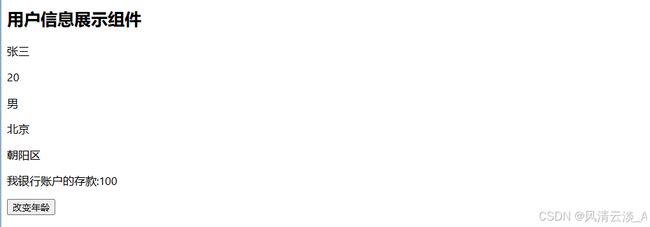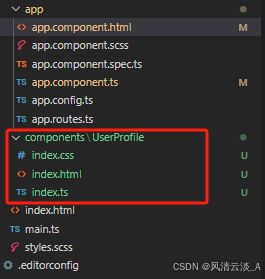- Spring Boot 项目分层架构详解
damnItHUA
后端springboot架构后端
在现代SpringBoot项目中,Controller、Service、Mapper和Entity四层架构能够有效提升代码可维护性、可测试性与团队协作效率。下面以“商品管理(Product)”为例,系统梳理这四层的职责分工与协作关系。一、Controller层作为Springboot应用程序的入口点,Controller层主要负责接收来自前端或其他系统的HTTP请求,校验输入参数,将业务委托给Se
- 使用CSS @layer控制样式优先级的新方式
海派程序猿
css前端
CSS@layer:拯救你的样式优先级,告别“!important”的焦虑各位前端同僚们,你们有没有经历过这样的噩梦?深夜,正当你准备结束一天的工作,舒舒服服地躺在床上刷手机时,测试突然甩来一个bug:一个看起来简单的样式问题,却怎么改都改不过来!你瞪大了眼睛,一行一行地检查CSS,发现优先级简直乱成了一锅粥。仿佛无数个小恶魔在你代码里跳舞,疯狂地嘲笑你的努力。最后,你无奈地祭出了“!import
- 从台式电脑硬件架构看前后端分离开发模式
程序猿全栈の董
电脑硬件架构状态模式
在软件开发领域,前后端分离早已成为主流架构设计理念。它将系统的业务逻辑处理与用户界面展示解耦,提升开发效率与系统可维护性。有趣的是,我们日常生活中常见的台式电脑硬件架构,竟与这一理念有着异曲同工之妙。今天,就让我们从台式电脑的硬件组成出发,深入探讨其与前后端分离开发模式的内在联系。文章目录一、台式电脑硬件架构与前后端的类比1.1主机:后端的硬件化身1.2显示屏:前端的硬件呈现二、二者分离模式的共同
- 前端 E2E 测试实践:打造稳定 Web 应用的利器!
朱公子的Note
编程语言前端端到端E2E测试
在现代Web开发中,端到端(E2E)测试就像为应用程序配备了一面“照妖镜”,它模拟真实用户的操作流程,从用户点击到获得反馈的每一步都进行验证。想象一下,你刚刚完成了一个完美的登录功能,结果用户反馈“点了登录按钮没有反应”——这种“我以为OK其实不行”的问题,正是E2E测试要解决的。E2E测试并不止于前端界面,它涵盖了前端、后端及数据库等所有环节,确保每个节点都能正常工作。历史经验也提醒我们其重要性
- 钉钉小程序开发的技术选型
脑袋大大的
钉钉生态创业者专栏钉钉小程序
作为一名专注于前端技术发展的技术博主,今天我将分享一下在进行钉钉小程序开发时关于技术选型的一些思考和经验。本文旨在探讨uni-app、Taro等跨平台框架与原生开发框架之间的优缺点,并最终推荐一个我认为最适合当前需求的技术栈组合。着急想知道答案的可以直接滑到最后看小编觉得好的解决方案吧!多端开发框架vs原生开发框架uni-appuni-app是一个基于Vue.js的跨平台开发框架,它允许开发者通过
- 钉钉小程序开发实战:打造一个简约风格的登录页面
脑袋大大的
钉钉生态创业者专栏钉钉小程序
在上一篇文章中,我们已经介绍了如何搭建钉钉小程序的基础环境,并完成了项目的初始化配置。本文将继续深入,手把手带你实现一个简约风格的登录页面,这是大多数企业级应用不可或缺的一部分。钉钉小程序基于前端Web技术栈,采用类似于Vue的模板语法和组件化结构,非常适合快速构建轻量级企业内部应用。登录页虽然看似简单,但却是用户与系统交互的第一步,良好的体验和简洁的设计往往能给用户留下深刻印象。本章节直接上干货
- 校园志愿者系统前端代码实现及技术解析
创新工场
本文还有配套的精品资源,点击获取简介:本项目集中展示了Web开发中的关键技术和框架,包含PHP、Vue.js、ElementUI和Laravel在校园志愿者系统前台构建中的应用。首先,PHP用于后端开发,处理业务逻辑并与数据库交互。接着,Vue.js作为前端框架,实现交云动界面和用户交互。ElementUI提供企业级UI组件,加速开发流程,提高界面美观度。Laravel框架则用于搭建后端架构,处理
- 前后端分离与不分离解析,很全面!
涔溪
前端
从多个维度对前后端分离与不分离进行更加深入、系统的分析,包括技术架构、开发流程、部署维护、性能优化、团队协作、适用场景等方面全面理解两者的区别和优劣。一、概念定义1.前后端不分离(传统服务端渲染)前端页面由服务器端生成并返回给浏览器,如PHP、JSP、ASP.NET等。前端逻辑和后端业务耦合在一起,通常一个请求对应一个完整的HTML页面。2.前后端分离(现代Web开发模式)前端独立开发为一个完整的
- 关于uniapp+vue2 升级 Vue3 后无法获取 query的问题
代码简单说
2025开发必备(限时特惠)uni-appvue2迁移到vue3获取不到query小程序获取不到querymp获取不到路由路由参数获取url参数获取
关于uniapp+vue2升级Vue3后无法获取query的问题tag:vue3迁移、uniapp兼容性、$mp变更、vue2升级、前端坑点记录在升级公司项目的时候,从uniapp+Vue2迁移到uniapp+Vue3,想着应该是个平滑过渡,没成想,一个小小的$mp把我绊了一脚。事情是这样的项目中有这么一段代码,用于判断当前页面的路由参数:onLoad(){constscene=this.
- 【DeepSeek实战】3、Ollama实战指南:LobeChat+多网关架构打造高可用大模型集群
无心水
Ollama实战指南LobeChat实战DeepSeek实战DeepSeek全栈应用开发AI入门大模型CSDN技术干货
一、企业级大模型集群架构全景解析在人工智能落地应用的过程中,大模型服务的高可用性、成本控制和灵活扩展能力成为企业关注的核心痛点。本方案通过LobeChat前端、AI网关层和Ollama模型集群的三层架构设计,实现了无需复杂运维即可部署的生产级大模型服务体系。该架构不仅支持负载均衡、故障转移和模型热切换等企业级特性。还通过量化技术将硬件成本降低60%以上,为中小企业提供了与商业云服务相当的性能体验。
- 移动端iOS调试与问题解决:WebView调试多工具协作
游戏开发爱好者8
httpudphttpswebsocket网络安全网络协议tcp/ip
在开发过程中,调试工作不仅仅是前端开发者的职责。当出现复杂的线上问题,调试往往需要涉及到多个团队的协作:前端、后端、测试和运营等。尤其是在移动端WebView页面和原生页面混合开发中,调试工作通常是多部门之间的互动与配合。这篇文章分享了我们在一个社交平台项目中的调试实践,重点讲解了跨团队合作调试中的问题解决策略,并介绍了我们如何通过工具协同与有效沟通,解决了上线后部分用户出现的问题。背景:移动端W
- 平台再升级!接入DeepSeek AI,三大能力一键生成
橙武科技
低代码AIdeepseek人工智能
在数字化项目落地过程中,很多企业都会面临相同的问题:数据库建模要写SQL表结构;业务流程需要画LogicFlow流程图;前端页面还要写AMISJSON配置。从想法到实现,中间至少要经历产品经理、架构师、后端、前端多轮沟通。每个环节都耗时,改起来还要推翻重来。demo地址:https://admin.cwcode.top✨我们的平台,现在直接整合了DeepSeekAI大模型只要输入一句需求,就能:✅
- 前端用MQTT协议通信的场景和好处
CreatorRay
前端网络面试前端MQTT网络协议物联网
上家公司中前端项目有用MQTT协议和硬件通信的场景,虽然很早就听说过MQTT协议,但是这是第一次在前端项目里基于MQTT协议做网络通信。当时没了解太多,工作中只做好了代码层面的工作,并没有深入了解MQTT协议的好处和适合的应用场景。在前端项目中,应该99%的情况都会基于HTTP和WebSocket来进行网络通信,使用MQTT在前端里确实比较小众。目前可能只会在物联网项目中,需要跟硬件通信的前提下,
- HTML页面设计——动态照片环
#前端开发##html超文本标记语言结构学习他的标签##css美化页面其实一部分的网站首页应用了照片环的原理,使得页面看起来更加美观,这里为大家分享一个简单的照片环编写。一、准备好以下素材:二、新建一个HTML文件,这里就取名“01-照片环”好了。三、现在开始编写具体内容,照片环说白了就是几个照片构成的所以body只要写就可以了,编写的时候注意图片的格式是.jpg、.png还是.gif(动态图)。
- vue-cron: Cron表达式UI组件开发指南
刘通双Elsie
vue-cron:Cron表达式UI组件开发指南项目地址:https://gitcode.com/gh_mirrors/vu/vue-cron项目介绍vue-cron是一个基于Vue框架设计的cron表达式UI组件库.该项目特别适用于那些需要在前端界面中提供cron表达式编辑功能的应用场景。通过简洁直观的接口,开发者可以轻松地将此组件集成到他们的Vue应用程序中,以实现对定时任务计划的精确控制。该
- vue el-date-picker 直接赋值时控件失效
梓暮
ITvue.js前端elementui
项目场景:前端vueel-date-picker控件无故失效问题描述本人是主打后端,新进的公司要求前后端全干,然后又因为前端做得少,所以经常碰到一些奇怪的问题,比如以下操作,是给vue前端el-date-picker这个时间控件赋值,但是发现,数据是赋值上去了,但是控件失效了,怎么点都没用if(resData.batchEntity.manage_scene_start_time!=null&&r
- java毕业设计房产中介系统mybatis+源码+调试部署+系统+数据库+lw
兮兮科技
javamybatis开发语言
java毕业设计房产中介系统mybatis+源码+调试部署+系统+数据库+lwjava毕业设计房产中介系统mybatis+源码+调试部署+系统+数据库+lw本源码技术栈:项目架构:B/S架构开发语言:Java语言开发软件:ideaeclipse前端技术:Layui、HTML、CSS、JS、JQuery等技术后端技术:JAVA运行环境:Win10、JDK1.8数据库:MySQL5.7/8.0源码地址
- vue大数据量列表渲染性能优化:虚拟滚动原理
Java小卷
Vue3开源组件实战vue3自定义Tree虚拟滚动
前面咱完成了自定义JuanTree组件各种功能的实现。在数据量很大的情况下,我们讲了两种实现方式来提高渲染性能:前端分页和节点数据懒加载。前端分页小节:Vue3扁平化Tree组件的前端分页实现节点数据懒加载小节:ElementTreePlus版功能演示:数据懒加载关于扁平化结构Tree和嵌套结构Tree组件的渲染嵌套结构的Tree组件是一种递归渲染,性能上比起列表结构的v-for渲染比较一般。对于
- 前端編譯 : Babel 基礎入門
林cc
前端babel前端
前端編譯:Babel基礎入門前言正文什麼是Babel?Babel模塊介紹babel-cli從項目中運行BabelCLIbabel-registerbabel-nodebabel-core配置Babel.babelrcbabel-preset-es2015babel-preset-react執行Babel生成的代碼babel-polyfillbabel-runtimepresetsvsplugins
- 前端跨域解决方案(10):document.domain
骆驼Lara
前端跨域解决方案汇总前端javascript
1document.domain核心同源策略要求两个页面的协议、域名、端口完全一致,否则视为跨域。例如:主域名site.com与子域名a.site.com因域名不同,属于跨域;http://a.site.com:8080与http://a.site.com:80因端口不同,属于跨域。document.domain允许将子域的域名设置为共同的主域名(如site.com),使浏览器认为不同子域“同源”
- 前端跨域解决方案(8):window.name
1window.name核心window.name是浏览器窗口的一个属性,它有两个关键特性:跨域共享:无论窗口的URL如何变化,window.name的值始终保持不变;容量大:可存储最大约2MB的数据(不同浏览器略有差异)。这使得window.name成为跨域通信的一种特殊方式:通过iframe加载跨域页面,利用window.name传递数据。window.name跨域的核心流程如下:主页面创建指
- 前端跨域解决方案(9):location.hash
骆驼Lara
前端跨域解决方案汇总前端javascript
1location.hash核心location.hash是URL中的锚点(如#section),它有两个关键特性:跨域可见:在A域名页面中,可通过iframe加载B域名页面,并修改其location.hash;不影响页面:修改hash不会触发页面刷新,也不会将数据发送到服务器。这使得location.hash成为跨域通信的一种轻量级方式:通过iframe加载跨域页面,利用location.has
- 前端开发者必看:Node.js实战技巧大揭秘
大厂前端小白菜
前端开发实战node.jsvim编辑器ai
前端开发者必看:Node.js实战技巧大揭秘关键词:前端开发者、Node.js、实战技巧、模块化开发、性能优化、Express框架、Webpack摘要:本文专为前端开发者打造,旨在深入揭秘Node.js的实战技巧。首先介绍了Node.js的背景和对前端开发的重要性,接着详细阐述了Node.js的核心概念与联系、核心算法原理及具体操作步骤,通过数学模型和公式进一步加深理解。然后结合实际案例,从开发环
- 前端跨域解决方案(7):Node中间件
骆驼Lara
前端跨域解决方案汇总前端中间件javascript
1Node中间件核心1.1为什么开发环境需要Node代理?在前端开发中,我们常遇到:前端运行在localhost:3000,后端API在localhost:4000,跨域导致请求失败。而传统解决方案有以下局限性:修改后端CORS配置:需后端开发配合,增加沟通成本;生产环境与开发环境配置不一致。配置Nginx反向代理:修改配置后需重启服务,打断开发流程;配置文件管理复杂。Node中间件代理(如htt
- ios15及以上webview、Safari使用Websocket断连,1006无清晰错误码
文章目录问题表现:定位疑似原因:解决方式:定位问题思路过程记录:1、对比前端代码运行环境问题2、写纯请求前端代码连接,确认是否接口部署服务问题;3、IOS连接是否有对TSL安全协议版本有要求(使用的wss协议)4、验证iOS网络是否稳定&查阅信息是否iOS会出现频繁断连又迅速重连情况5、自己搞个nodedemo验证纯连接问题:6、IOS自身多运行环境对比:QQ频道应用、QQ聊天框、safari、c
- Gitee 持续集成与交付(CI/CD)篇
Gitee持续集成与交付(CI/CD)篇文章目录Gitee持续集成与交付(CI/CD)篇什么是CI/CD?GiteeGo介绍✨核心特性支持的技术栈提交项目进行CI/CD第一步:创建.gitee-ci.yml文件第二步:配置项目设置第三步:提交代码触发构建制品库配置Maven制品库配置Docker制品库配置npm制品库配置⚙️流水线配置示例与实践JavaSpringBoot项目示例Vue.js前端项
- 【数字IC前端笔试真题精刷(2022.7.28)】芯动——数字IC验证工程师(1号卷-验证)
ReRrain
#数字IC笔试
声明:本专栏所收集的数字IC笔试题目均来源于互联网,仅供学习交流使用。如有侵犯您的知识产权,请及时与博主联系,博主将会立即删除相关内容。笔试时间:2022-7-28;题目类型:不定项(10x1’=10’)【错选不得分,少选得1/3分】问答(9x10’=90’)文章目录不定项1、(单选)在verilog语言中,a=4'b1011,那么&a=()2、(单选)SystemVerilog中类默认的成员属性
- 【架构篇】微前端架构设计与qiankun实战
全息架构师
Java前沿探索:引领技术新风尚架构前端
【架构篇】微前端架构设计与qiankun实战阅前必看:本文是《前端开发完全指南》系列的第十七篇,包含15个核心代码示例、8张系统架构图解、2个企业级落地案例。通过qiankun+ModuleFederation实现前端应用自由组合,支撑百万级PV应用!目录微前端核心价值技术方案全景对比qiankun架构设计主子应用通信方案样式隔离方案沙箱机制解析资源加载优化权限体系集成性能监控方案中台系统实战一、
- 实用前端vue页面引入 .md文件
xqqwyy
vuevue.js前端javascriptvue
项目场景:提示:这里简述项目相关背景:vue前端页面引入.md文件解决方案:提示:这里填写该问题的具体解决方案:1.安装依赖npminstallvue-markdown-loader--save2.vue.config.js中配置chainWebpack:config=>{config.module.rule("md").test(/\.md/).use("vue-loader").loader(
- 每天一个前端小知识 Day 14 - 前端状态管理深入实践
蓝婷儿
前端面试前端
前端状态管理深入实践(Redux、Pinia、Zustand等)为什么需要状态管理?当组件之间状态通信越来越复杂时,靠props和事件传递会变得非常难维护。状态管理工具提供:目标实现方式状态集中管理将状态集中存放,避免组件深层传递状态可预测、可追踪有清晰的流转逻辑(Action→Reducer→Store)跨组件通信无需propsdrilling(逐层传递)支持模块拆分与中间件支持插件化、按模块加
- Java实现的基于模板的网页结构化信息精准抽取组件:HtmlExtractor
yangshangchuan
信息抽取HtmlExtractor精准抽取信息采集
HtmlExtractor是一个Java实现的基于模板的网页结构化信息精准抽取组件,本身并不包含爬虫功能,但可被爬虫或其他程序调用以便更精准地对网页结构化信息进行抽取。
HtmlExtractor是为大规模分布式环境设计的,采用主从架构,主节点负责维护抽取规则,从节点向主节点请求抽取规则,当抽取规则发生变化,主节点主动通知从节点,从而能实现抽取规则变化之后的实时动态生效。
如
- java编程思想 -- 多态
百合不是茶
java多态详解
一: 向上转型和向下转型
面向对象中的转型只会发生在有继承关系的子类和父类中(接口的实现也包括在这里)。父类:人 子类:男人向上转型: Person p = new Man() ; //向上转型不需要强制类型转化向下转型: Man man =
- [自动数据处理]稳扎稳打,逐步形成自有ADP系统体系
comsci
dp
对于国内的IT行业来讲,虽然我们已经有了"两弹一星",在局部领域形成了自己独有的技术特征,并初步摆脱了国外的控制...但是前面的路还很长....
首先是我们的自动数据处理系统还无法处理很多高级工程...中等规模的拓扑分析系统也没有完成,更加复杂的
- storm 自定义 日志文件
商人shang
stormclusterlogback
Storm中的日志级级别默认为INFO,并且,日志文件是根据worker号来进行区分的,这样,同一个log文件中的信息不一定是一个业务的,这样就会有以下两个需求出现:
1. 想要进行一些调试信息的输出
2. 调试信息或者业务日志信息想要输出到一些固定的文件中
不要怕,不要烦恼,其实Storm已经提供了这样的支持,可以通过自定义logback 下的 cluster.xml 来输
- Extjs3 SpringMVC使用 @RequestBody 标签问题记录
21jhf
springMVC使用 @RequestBody(required = false) UserVO userInfo
传递json对象数据,往往会出现http 415,400,500等错误,总结一下需要使用ajax提交json数据才行,ajax提交使用proxy,参数为jsonData,不能为params;另外,需要设置Content-type属性为json,代码如下:
(由于使用了父类aaa
- 一些排错方法
文强chu
方法
1、java.lang.IllegalStateException: Class invariant violation
at org.apache.log4j.LogManager.getLoggerRepository(LogManager.java:199)at org.apache.log4j.LogManager.getLogger(LogManager.java:228)
at o
- Swing中文件恢复我觉得很难
小桔子
swing
我那个草了!老大怎么回事,怎么做项目评估的?只会说相信你可以做的,试一下,有的是时间!
用java开发一个图文处理工具,类似word,任意位置插入、拖动、删除图片以及文本等。文本框、流程图等,数据保存数据库,其余可保存pdf格式。ok,姐姐千辛万苦,
- php 文件操作
aichenglong
PHP读取文件写入文件
1 写入文件
@$fp=fopen("$DOCUMENT_ROOT/order.txt", "ab");
if(!$fp){
echo "open file error" ;
exit;
}
$outputstring="date:"." \t tire:".$tire."
- MySQL的btree索引和hash索引的区别
AILIKES
数据结构mysql算法
Hash 索引结构的特殊性,其 检索效率非常高,索引的检索可以一次定位,不像B-Tree 索引需要从根节点到枝节点,最后才能访问到页节点这样多次的IO访问,所以 Hash 索引的查询效率要远高于 B-Tree 索引。
可能很多人又有疑问了,既然 Hash 索引的效率要比 B-Tree 高很多,为什么大家不都用 Hash 索引而还要使用 B-Tree 索引呢
- JAVA的抽象--- 接口 --实现
百合不是茶
抽象 接口 实现接口
//抽象 类 ,方法
//定义一个公共抽象的类 ,并在类中定义一个抽象的方法体
抽象的定义使用abstract
abstract class A 定义一个抽象类 例如:
//定义一个基类
public abstract class A{
//抽象类不能用来实例化,只能用来继承
//
- JS变量作用域实例
bijian1013
作用域
<script>
var scope='hello';
function a(){
console.log(scope); //undefined
var scope='world';
console.log(scope); //world
console.log(b);
- TDD实践(二)
bijian1013
javaTDD
实践题目:分解质因数
Step1:
单元测试:
package com.bijian.study.factor.test;
import java.util.Arrays;
import junit.framework.Assert;
import org.junit.Before;
import org.junit.Test;
import com.bijian.
- [MongoDB学习笔记一]MongoDB主从复制
bit1129
mongodb
MongoDB称为分布式数据库,主要原因是1.基于副本集的数据备份, 2.基于切片的数据扩容。副本集解决数据的读写性能问题,切片解决了MongoDB的数据扩容问题。
事实上,MongoDB提供了主从复制和副本复制两种备份方式,在MongoDB的主从复制和副本复制集群环境中,只有一台作为主服务器,另外一台或者多台服务器作为从服务器。 本文介绍MongoDB的主从复制模式,需要指明
- 【HBase五】Java API操作HBase
bit1129
hbase
import java.io.IOException;
import org.apache.hadoop.conf.Configuration;
import org.apache.hadoop.hbase.HBaseConfiguration;
import org.apache.hadoop.hbase.HColumnDescriptor;
import org.apache.ha
- python调用zabbix api接口实时展示数据
ronin47
zabbix api接口来进行展示。经过思考之后,计划获取如下内容: 1、 获得认证密钥 2、 获取zabbix所有的主机组 3、 获取单个组下的所有主机 4、 获取某个主机下的所有监控项
- jsp取得绝对路径
byalias
绝对路径
在JavaWeb开发中,常使用绝对路径的方式来引入JavaScript和CSS文件,这样可以避免因为目录变动导致引入文件找不到的情况,常用的做法如下:
一、使用${pageContext.request.contextPath}
代码” ${pageContext.request.contextPath}”的作用是取出部署的应用程序名,这样不管如何部署,所用路径都是正确的。
- Java定时任务调度:用ExecutorService取代Timer
bylijinnan
java
《Java并发编程实战》一书提到的用ExecutorService取代Java Timer有几个理由,我认为其中最重要的理由是:
如果TimerTask抛出未检查的异常,Timer将会产生无法预料的行为。Timer线程并不捕获异常,所以 TimerTask抛出的未检查的异常会终止timer线程。这种情况下,Timer也不会再重新恢复线程的执行了;它错误的认为整个Timer都被取消了。此时,已经被
- SQL 优化原则
chicony
sql
一、问题的提出
在应用系统开发初期,由于开发数据库数据比较少,对于查询SQL语句,复杂视图的的编写等体会不出SQL语句各种写法的性能优劣,但是如果将应用系统提交实际应用后,随着数据库中数据的增加,系统的响应速度就成为目前系统需要解决的最主要的问题之一。系统优化中一个很重要的方面就是SQL语句的优化。对于海量数据,劣质SQL语句和优质SQL语句之间的速度差别可以达到上百倍,可见对于一个系统
- java 线程弹球小游戏
CrazyMizzz
java游戏
最近java学到线程,于是做了一个线程弹球的小游戏,不过还没完善
这里是提纲
1.线程弹球游戏实现
1.实现界面需要使用哪些API类
JFrame
JPanel
JButton
FlowLayout
Graphics2D
Thread
Color
ActionListener
ActionEvent
MouseListener
Mouse
- hadoop jps出现process information unavailable提示解决办法
daizj
hadoopjps
hadoop jps出现process information unavailable提示解决办法
jps时出现如下信息:
3019 -- process information unavailable3053 -- process information unavailable2985 -- process information unavailable2917 --
- PHP图片水印缩放类实现
dcj3sjt126com
PHP
<?php
class Image{
private $path;
function __construct($path='./'){
$this->path=rtrim($path,'/').'/';
}
//水印函数,参数:背景图,水印图,位置,前缀,TMD透明度
public function water($b,$l,$pos
- IOS控件学习:UILabel常用属性与用法
dcj3sjt126com
iosUILabel
参考网站:
http://shijue.me/show_text/521c396a8ddf876566000007
http://www.tuicool.com/articles/zquENb
http://blog.csdn.net/a451493485/article/details/9454695
http://wiki.eoe.cn/page/iOS_pptl_artile_281
- 完全手动建立maven骨架
eksliang
javaeclipseWeb
建一个 JAVA 项目 :
mvn archetype:create
-DgroupId=com.demo
-DartifactId=App
[-Dversion=0.0.1-SNAPSHOT]
[-Dpackaging=jar]
建一个 web 项目 :
mvn archetype:create
-DgroupId=com.demo
-DartifactId=web-a
- 配置清单
gengzg
配置
1、修改grub启动的内核版本
vi /boot/grub/grub.conf
将default 0改为1
拷贝mt7601Usta.ko到/lib文件夹
拷贝RT2870STA.dat到 /etc/Wireless/RT2870STA/文件夹
拷贝wifiscan到bin文件夹,chmod 775 /bin/wifiscan
拷贝wifiget.sh到bin文件夹,chm
- Windows端口被占用处理方法
huqiji
windows
以下文章主要以80端口号为例,如果想知道其他的端口号也可以使用该方法..........................1、在windows下如何查看80端口占用情况?是被哪个进程占用?如何终止等. 这里主要是用到windows下的DOS工具,点击"开始"--"运行",输入&
- 开源ckplayer 网页播放器, 跨平台(html5, mobile),flv, f4v, mp4, rtmp协议. webm, ogg, m3u8 !
天梯梦
mobile
CKplayer,其全称为超酷flv播放器,它是一款用于网页上播放视频的软件,支持的格式有:http协议上的flv,f4v,mp4格式,同时支持rtmp视频流格 式播放,此播放器的特点在于用户可以自己定义播放器的风格,诸如播放/暂停按钮,静音按钮,全屏按钮都是以外部图片接口形式调用,用户根据自己的需要制作 出播放器风格所需要使用的各个按钮图片然后替换掉原始风格里相应的图片就可以制作出自己的风格了,
- 简单工厂设计模式
hm4123660
java工厂设计模式简单工厂模式
简单工厂模式(Simple Factory Pattern)属于类的创新型模式,又叫静态工厂方法模式。是通过专门定义一个类来负责创建其他类的实例,被创建的实例通常都具有共同的父类。简单工厂模式是由一个工厂对象决定创建出哪一种产品类的实例。简单工厂模式是工厂模式家族中最简单实用的模式,可以理解为是不同工厂模式的一个特殊实现。
- maven笔记
zhb8015
maven
跳过测试阶段:
mvn package -DskipTests
临时性跳过测试代码的编译:
mvn package -Dmaven.test.skip=true
maven.test.skip同时控制maven-compiler-plugin和maven-surefire-plugin两个插件的行为,即跳过编译,又跳过测试。
指定测试类
mvn test
- 非mapreduce生成Hfile,然后导入hbase当中
Stark_Summer
maphbasereduceHfilepath实例
最近一个群友的boss让研究hbase,让hbase的入库速度达到5w+/s,这可愁死了,4台个人电脑组成的集群,多线程入库调了好久,速度也才1w左右,都没有达到理想的那种速度,然后就想到了这种方式,但是网上多是用mapreduce来实现入库,而现在的需求是实时入库,不生成文件了,所以就只能自己用代码实现了,但是网上查了很多资料都没有查到,最后在一个网友的指引下,看了源码,最后找到了生成Hfile
- jsp web tomcat 编码问题
王新春
tomcatjsppageEncode
今天配置jsp项目在tomcat上,windows上正常,而linux上显示乱码,最后定位原因为tomcat 的server.xml 文件的配置,添加 URIEncoding 属性:
<Connector port="8080" protocol="HTTP/1.1"
connectionTi

